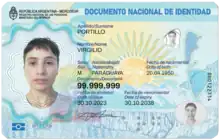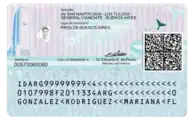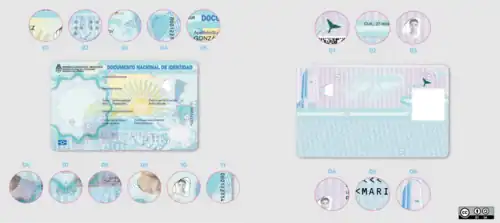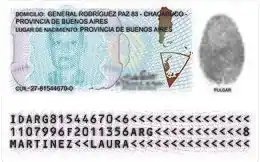| Argentine identity card (Documento nacional de identidad) | |
|---|---|
 Documento Nacional de Identidad | |
 Reverse | |
| Type | Identity card |
| Issued by | |
| Purpose | Proof of identity, Travel |
| Valid in | |
| Eligibility | Citizens and lawful permanent residents of Argentina |
Documento Nacional de Identidad or DNI[1] (which means National Identity Document[2]) is the main identity document for Argentine citizens, as well as temporary or permanent resident aliens (DNI Extranjero). It is issued at a person's birth, and must be updated at 8 and 14 years of age, and thereafter every 15 years. It takes the form of a card (DNI tarjeta), and is required for voting, payments, military service inscriptions and formalities. They are issued by the National Registry of Persons (RENAPER).
The front side of the card states, in both English and Spanish, the name, sex, nationality, specimen issue, date of birth, date of issue, date of expiry, and transaction number along with the DNI number, portrait, and signature of the card's bearer. The back side of the card shows the address of the card's bearer (and it used to show with their right thumbprint along). Both back sides of the card shows a QR code, and a machine-readable information. The unique DNI number is semi-perforated through the front-right side of the card. Also, biometric version includes braile support.
The DNI is a valid international travel document to enter the member countries of Mercosur (Brazil, Paraguay, Uruguay and Venezuela) and countries associated to the bloc (Bolivia, Chile, Colombia, Ecuador and Peru).[3]
History
Before the introduction of the DNI in 1968, women had a Libreta cívica ("civic booklet"); men a Libreta de enrolamiento ("(military) enrollment booklet").[4][5] For many years, the DNI was issued as a small green booklet (called libreta). In 2009, the DNI was revamped and digitalized; and booklets (now blue) were issued along with an identity card simultaneously. Since 2012, DNIs are issued only in card format. The new DNI card is required to obtain the new biometric Argentine passport. Foreigners can get it at “RadEx” system but "extranjero" (foreigner) is printed on the back side. Argentines can get a libro de matrícula, which is only for citizens, in consulates.[6]
In 2020, the DNI card was restyled to show the new bicontinental official map of Argentina.[7][8]
On 20 July 2021, President Alberto Fernández signed a decree (Decreto 476/2021) mandating the RENAPER to allow a third gender option on all DNI cards and passports, marked as an "X". The measure applies to non-citizen permanent residents who possess Argentine identity cards as well.[9] In compliance with the 2012 Gender Identity Law, this made Argentina the first country in South America to legally recognize non-binary gender on all official documentation, freely and upon the person's request.[10][11][12]
In April 2023, an important development occurred in Argentina with regards to the DNI. This development marked a significant step in the ongoing historical narrative surrounding the Falkland Islands (known as the Malvinas Islands in Argentina) and the recognition of the contributions and sacrifices made by its veterans, putting a new 'seal' with the geographic map of it, with the legend "HEROE DE LAS ISLAS MALVINAS".[13] This update was mandatory only for war veterans.[14]
As of December 2023, the Argentine National Registry of Persons (Renaper), operating under the Ministry of Interior, has introduced the new Biometric National Identity Document (DNI). This cutting-edge identification document stands out for its adherence to the highest international standards in terms of security, technology, and quality. It incorporates an electronic chip and a QR code, enabling electronic document validation, identity verification, digital functionalities, and enhanced security measures.
Printed using laser technology on polycarbonate, the new document incorporates advanced physical security features to enhance visual verification and prevent counterfeiting. Polycarbonate, known for its durability, serves as the base material, providing increased resilience.[15]
Physical appearance

The current ID card is an ID-1 (credit card size) polycarbonate with an embedded RFID chip. It is covered with multi-color guillochés and appears blue and light-blue from a distance. All the information on it (except for nationality, DOCUMENTO NACIONAL DE IDENTIDAD, and everthing on the rear side), is given in Spanish, and English.
Front side
The front side shows the Sun of May, the Cockade,A Bicontinental Map, three stars, and the words "DOCUMENTO NACIONAL DE IDENTIDAD República Argentina - Mercosur". It contains the following information:
- Photo of ID card holder (According to the national standards)
- Document number (8 alphanumeric digits)
- Surname
- Given name(s)
- Date of birth (dd.mm.yyyy)
- Date of expiry (dd.mm.yyyy)
- Date of issue (dd.mm.yyyy)
- Nationality (ARGENTINA, or any other for foreign residents)
- Sex
- Signature of holder
Rear side
The rear side shows the National Flag Memorial, the Argentina Flag, Falkland Islands map, the Ceibo flower, and the Southern right whale. It contains the following information:
- Adress of residence
- Place of birth
- No of procedure
- CUIL No
- QR code
- Machine-readable zone
For non-citizens, it is also added:
- Country of birth
- Date of entry (into the nation) (dd.mm.yyyy)
- Entry category (TEMPORARIA or PERMANENTE)
- Disposición
- Filing date (dd.mm.yyyy)
- Expiry (Only for temporary) (dd.mm.yyyy)
Machine-readable zone
The MRZ is structured according to the ICAO standard for machine-readable ID cards:
First line
| positions | text | meaning |
|---|---|---|
| 1–2 | ID | identity document |
| 3-5 | ARG | issuing country: Argentina (Argentina) |
| 6–14 | alphanumeric digits | document number |
| 15 | decimal digit | check digit over 6–14 |
Second line
| positions | text | meaning |
|---|---|---|
| 1–6 | decimal digits | date of birth (YYMMDD) |
| 7 | decimal digit | check digit over 1–6 |
| 8 | decimal digit | First letter of the name or seccond name |
| 9–14 | decimal digits | date of expiry (YYMMDD) |
| 15 | decimal digit | check digit over 9–14 |
| 16-18 | ARG | code of the country: Argentina (Argentina) |
| 30 | decimal digit | check digit over 6–30 (upper line), 1–7, 9–15, 19–29 (middle line) |
Third line
| positions | text | meaning |
|---|---|---|
| 1–30 | alphabetic digits<alphabetic digits<alphabetic digits | SURNAME<< GIVEN<NAMES |
Empty spaces are represented by "<".
Security features
The identity card contains the following security features:[16]
- Front
- Rainbow print or iris print
- Printing of touch surfaces
- Offset printing composed of security backgrounds
- Guilloche of two colors
- Line Width Modulation
- Integrated Transparent Hologram
- Matte surface printing
- Numismatic print design
- Safety background merged with portrait area
- Transparent window
- Pre customized serial number
- Repeating photos within a transparent window (ghost image)
- Laser engraved personal data
- Changing laser imaging
- Changeable portrait photo repetition with copy letter
- Tactile laser engraving on the date of birth data
- Transparent liquid coating of the photographic portrait with typographic personalization of the surname and date of birth
- Safety background merged with portrait area
- Rear
- OVI optically variable ink.
- Offset printing of security backgrounds
- Transparent window (with mismatched shapes)
- Rainbow print
- Line width modulation
- Numismatic Print Design
Chip
Newer ID cards contain an ICAO recommendations compatible RFID chip. The chip stores the information given on the ID card (like name or date of birth), the holder's picture and fingerprints. In addition, the new ID card can be used for online authentication, governmental transactions, digital certificate, access to Online Services, etc. An electronic signature, provided by a private company, can also be stored on the chip.[17] The fingerprints take is mandatory. However, there are rare exceptions to this rule, for medical issues, for example.[18] They are uploaded to the Sistema Federal de Identificación Biométrica para la Seguridad (SIBIOS) (Criminal database).[19]
Problems and challenges
The main issues of the Argentine Identity cards are mainly the price, due to the inflation, and it has been reported to be fairly high.[20] Exceptions of payments can be made to those people who have a "Certificado de Pobreza". However, internet access is required due to the use of TAD (Trámites a distancia).[21]
In the elections of 2023 there were some issues with old documents, such as the old "DNI Card" (delivered with the old blue booklet) that said "NO VÁLIDO PARA VOTAR" (Not valid as a vote proof). That, in fact, it was actually valid. This also included the electoral census issues.[22]
Old booklet
Earlier Identity cards in Argentina came in the form of paper booklets in a green cover for Argentines, Bordeaux cover for foreigners, much like modern day passports. On the outside, the Emblem of the Argentine Republic Republic as well as the words "Mercosur" "REPÚBLICA ARGENTINA" ("Argentine Republic"), "DOCUMENTO NACIONAL DE IDENITDAD", "REGISTRO NACIONAL DE LAS PERSONAS LEY 17.671" ("NATIONAL REGISTRY OF PERSONS LAW 17,671"), are embossed. Inside the cover page there was a place for votes proofs and addresses change. They also had the legends written "MENOR DE 16 AÑOS"(under 16 years)[23] and "EXTRANJERO"[24] (foreigner), respectively.[25] Inside the cover page there is a notice to the bearer:
La presentación del documento nacional de identidad, expedido por el Registro nacional de Personas, será obligatoria en todas las circunstancias comprendidas en esta Ley, sin que pueda ser suplido por ningún otro documento de identidad.
Art. 13 - Ley 17.671.
Todas las personas de existencia visible o sus representantes legales, comprendidas en la presente Ley, consulares o que se habiliten como tales, el "cambio de domicilio", dentro de los treinta días de haberse producido la novedad.
Art. 47 - Ley 17.671.
Which translates to:
The presentation of the national identity document, issued by the National Registry of Persons, will be mandatory in all circumstances covered by this Law, and it cannot be replaced by any other identification document.
Art. 13 - Law 17,671.
All persons of visible existence or their legal representatives, covered by this Law, consular or those who enable themselves as such, must report a "change of address" within thirty days of the occurrence of the change.
Art. 47 - Law 17,671.
Digital Booklet
By 2009, the Argentine Identity card has been "remade" in new blue booklet, made of a plastic,[26] incorporating new features. Most parts were "digitalized", incorporating new features, to prevent counterfeiting. However, some kept "handwritten" style in some parts. A new "card" version also was delivered for Argentines and non-citizens, residing in the country, as long as they were 16 years, or over, in all the cases.[27]
Gallery
 Front side of previous version of DNI card, issued 2012-2020
Front side of previous version of DNI card, issued 2012-2020 Back side of previous version of DNI card, issued 2012-2020
Back side of previous version of DNI card, issued 2012-2020 Front side of previous version of DNI card, issued 2009-2012
Front side of previous version of DNI card, issued 2009-2012 Back of oldest version of DNI card, issued 2009-2012
Back of oldest version of DNI card, issued 2009-2012 DNI blue booklet, issued 2009-2012
DNI blue booklet, issued 2009-2012 Previous green libreta version of the DNI, issued 1968–2009, until the new DNI cards began to be issued
Previous green libreta version of the DNI, issued 1968–2009, until the new DNI cards began to be issued Pre-biometric resident DNI specimen for a temporary foreigner.
Pre-biometric resident DNI specimen for a temporary foreigner. DNI issued since 2023 for Falkland Islands veterans (Issued until December 2023)[28]
DNI issued since 2023 for Falkland Islands veterans (Issued until December 2023)[28] The Argentine DNI (Documento nacional de identidad) with Falkland island (Malvinas) issued to Women veterans (Issued until 2023).
The Argentine DNI (Documento nacional de identidad) with Falkland island (Malvinas) issued to Women veterans (Issued until 2023). Pre-biometric Argentine DNI, which included Argentine Antarctica on the map.
Pre-biometric Argentine DNI, which included Argentine Antarctica on the map. Reverse of the pre-biometric Argentine DNI, which included Argentine Antarctica on the map.
Reverse of the pre-biometric Argentine DNI, which included Argentine Antarctica on the map. Argentine biometric DNI for Falkland Islands veterans, since December 2023.
Argentine biometric DNI for Falkland Islands veterans, since December 2023. Specimen of Argentine DNI for a temporary citizen (Back).
Specimen of Argentine DNI for a temporary citizen (Back). Specimen of Argentine DNI for a permanent citizen (Back).
Specimen of Argentine DNI for a permanent citizen (Back).
See also
References
- ↑ Nuevo DNI, Ministry of the Interior of Argentina, retrieved June 14, 2011
- ↑ New National Identity Document unveiled, Télam, archived from the original on August 15, 2011, retrieved June 14, 2011
- ↑ "Mercosur will not ask their South American members passport". Mendoza Travel. Retrieved 2017-06-09.
- ↑ Libreta de enrolamiento of Julio Cortázar Archived March 27, 2012, at the Wayback Machine
- ↑ Argentine government website: How Argentine citizens abroad can apply for a DNI with an existing Libreta cívica or Libreta de enrolamiento Archived August 4, 2011, at the Wayback Machine (in Spanish)
- ↑ "Consulado General en Madrid | Libro de matrícula". cmadr.cancilleria.gob.ar. Retrieved 2024-01-14.
- ↑ "El Gobierno lanzó un nuevo DNI: qué pasará con las versiones anteriores". La Nación (in Latin American Spanish). 25 November 2020.
- ↑ "Wado y Filmus presentaron el nuevo DNI que incluye una actualización del mapa bicontinental argentino". Argentina.gob.ar (in Latin American Spanish). Ministry of the Interior (Argentina). 20 November 2020.
- ↑ "Decreto 476/2021". Boletín Oficial de la República Argentina (in Spanish). 20 July 2021. Retrieved 21 July 2021.
- ↑ "Alberto Fernández pondrá en marcha el DNI para personas no binarias". Ámbito (in Spanish). 20 July 2021. Retrieved 21 July 2021.
- ↑ "Identidad de género: el Gobierno emitirá un DNI para personas no binarias". La Nación (in Spanish). 21 July 2021. Retrieved 21 July 2021.
- ↑ Westfall, Sammy (22 July 2021). "Argentina rolls out gender-neutral ID". The Washington Post. Retrieved 24 July 2021.
- ↑ "Taiana y de Pedro presentaron el nuevo diseño del DNI para héroes y heroínas de Malvinas". Argentina.gob.ar (in Spanish). 2023-04-04. Retrieved 2023-09-12.
- ↑ "Lanzaron un nuevo DNI: qué cambios tiene y quiénes podrán actualizarlo | Ciudadanos". La Voz del Interior (in Spanish). 2023-04-20. Retrieved 2023-09-12.
- ↑ "El Renaper lanza el nuevo DNI electrónico con chip que se adapta a los más altos estándares internacionales". Argentina.gob.ar (in Spanish). 2023-12-01. Retrieved 2024-01-13.
- ↑ "disp1255-2" (PDF).
- ↑ ""Disposición 1255/2023"" (PDF).
- ↑ "Tenía dificultades con sus huellas dactilares y a través del CAJ pudo obtener su DNI". Argentina.gob.ar (in Spanish). 2019-06-18. Retrieved 2024-01-14.
- ↑ bea (2012-01-10). "Biometría en Argentina: la vigilancia masiva como política de estado". FUNDACIÓN VÍA LIBRE (in Spanish). Retrieved 2024-01-14.
- ↑ Chandler, Sir (2024-01-08). "Sube el costo del pasaporte a $35.000". Sir Chandler (in Spanish). Retrieved 2024-01-13.
- ↑ "Certificado de Pobreza | Buenos Aires Ciudad - Gobierno de la Ciudad Autónoma de Buenos Aires". buenosaires.gob.ar. Retrieved 2024-01-13.
- ↑ "El DNI que dice "no es válido para votar" es válido (y es viral)". www.cronista.com (in Spanish). 2019-10-26. Retrieved 2024-01-13.
- ↑ "Ley 17671 del 29/02/68". servicios.infoleg.gob.ar. Retrieved 2024-01-13.
- ↑ "Re.Na.Per. | Instructivos de documentación". web.archive.org. 2008-06-11. Retrieved 2024-01-13.
- ↑ "Ley 17.671".
- ↑ "Anexo - I" Boletín oficial
- ↑ "Resolución 1800-2009".
- ↑ "Nuevo DNI: a quiénes corresponde esta actualización y cómo realiza el trámite". Yahoo Finance (in Spanish). 2023-04-20. Retrieved 2023-09-04.











